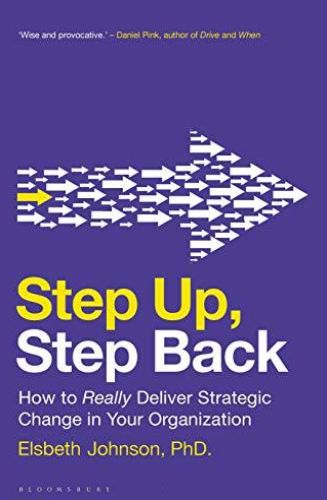Elsbeth Johnson of the MIT Sloan School of Management offers a detailed, actionable manual for leaders driving change and for students studying change implementation.

Change – Step by Step
Why do so many leaders’ change efforts fail? MIT Sloan School of Management senior lecturer Elsbeth Johnson – a visiting fellow at the London School of Economics and contributor to the Harvard Business Review – believes change initiatives come to grief because executives embrace delusional thinking about change. She encourages them to drop any notions of leadership gleaned from Hollywood dramas that overvalue charisma and influence and, instead, to invest in the hands-on work of organizational transformation.
Writing in a clear, accessible style and drawing on a wealth of change research, Johnson offers a strategy for change management that emphasizes how leaders should lead and how they should enable subordinates to apply their skills unimpeded by micromanagement.
Delusions
Bringing about enduring change takes time and patience, but Johnson finds that leaders who try to effectuate change often succumb to various fallacies. The Magic Delusion affects those who believe their personal magnetism drives change. When charismatic leaders tire, their impact dwindles and their companies must create change without them. The Activity Delusion hits when leaders try to drive change by starting small projects simultaneously to build early momentum instead of waiting until their company clarifies its objectives. The Drama Delusion affects leaders who feel change has to be exciting, so they pursue only high drama, high-stakes projects. Leaders fall prey to The Agency Delusion when they believe they can create change without organizational support.
All too often, the result of using only the old clichéd, charismatic leadership is that the change doesn’t stick. Elsbeth Johnson
These leaders overvalue transformational leadership and undervalue transactional leadership. Leaders must employ both styles to create successful change.
Research Biases
Many academics assume that most important metrics for change appear in its early stages; Johnson identifies this line of thinking as Early-Stage Bias. Agentic Bias occurs when researchers focus on change agents and ignore organizational structure. And Event Bias manifests when researchers focus on events that drive change instead of processes. Leaders must beware of these biases.
Step Up
The first step in productive change, Johnson says, is to Step Up by investing three months into considering the change you want and creating clarity around your change strategy and message. Create actionable metrics or targets that follow the path to your goals.
This approach will help you not only implement the change you want, but…do so in a way that means it is sustained. Elsbeth Johnson
Practice patience. Meaningful change doesn’t happen instantly. Once you create a strategy, be consistent about implementing it.
Clarity
Johnson urges you to explain why you’re committed to the change you want and to craft a strong narrative featuring near-term and long-term outcomes and targets. Explain why your strategy is pivotal to organizational success. Be specific about what you want.
The first ask of leaders when kicking off a new strategy or change – and the first way in which leaders need to step up and do more – is for them to clearly tell the organization what they want.Elsbeth Johnson
Motivate people to do the early-stage work related to metrics, data and systems by explaining their long-term impact and importance. Set clear timelines and financial targets. Step Up by communicating the purpose, behaviors and outcomes you want.
Focus
Leaders should focus their energy on the “green zone” of activities that define their company’s outcomes, behaviors and purpose. That means Stepping Back from activities inside the “blue zone” – the domain of managers. The blue zone includes deciding how teams will deliver change.
While most leaders have no problem with doing more, many have much more difficulty with this concept of doing less. Elsbeth Johnson
Give managers sufficient time to reflect on the changes they’re implementing and demonstrate patience as their changes take effect. Never give managers more projects than they can handle. Use short-term goals or milestones to gauge their progress toward long-term targets and stay curious about what they deliver and learn.
Alignment
During the first year of a change initiative, create alignment for your desired change. Don’t rely on official events and press releases to communicate your message. In the first months, have conversations every day about the change with your managers. Align your actions with the change and become a role model. For example, if you want to boost collaboration, embrace collaborative behaviors.
To embark on a change effort, make sure you have an appropriate and sufficient budget and the other resources necessary. Connect with those who have the authority and status to implement change. Collect and produce appropriate information and create key performance indicators (KPIs) with your managers and their teams. Letting team members decide how to achieve their goals bolsters worker retention and satisfaction. Reward your team members for achieving their intended outcomes.
Consistency
Call out leaders who push for inconsistent change. Use data from the first year of your ongoing change effort to demonstrate its benefits. Create consistency in the second year of your change. Make change routine and don’t get distracted by new ideas, initiatives or strategies that conflict with your ongoing change agenda.
What I mean by consistency is that nothing should happen at this stage that is incompatible with the new strategy or change. In other words, leaders need to stick with the strategy until it is implemented.Elsbeth Johnson
Your organization is made up of both people and structure. They must interact to support change. Managers should consider how new strategies affect their delivery of the original change strategy. Managers should make the most of their leaders’ support to facilitate their change-initiative work.
Meaningful Autonomy
You can trust managers who demonstrate accountability, clarity, focus, alignment and consistency to deliver your change vision. Never micromanage managers.
Meaningful autonomy is, of course, a prize for managers – at least for the ones who want to exercise their autonomy without the need to check in with those above them. Elsbeth Johnson
Create an internal think tank group to assess external developments and test new ideas. If you adopt a new strategy, explain how it might affect existing priorities and how it aligns with efforts that are already underway.
Great Clarity
Johnson shifts between writing like an equity analyst – dry but with wit – and a senior lecturer – didactic but with great clarity. She doesn’t reach out to the reader, but she won’t bore you either. She takes a remarkably long view, which underscores her real-world organizational change experience, yet she never neglects the day-to-day details of both the work leaders must do and the attitudes they must manifest, which includes staying out of their subordinates’ way. Johnson recognizes and underscores the seeming contradictions of being in charge while not being hands-on as she guides leaders through this complex territory.
This is a foundational work for leaders on all levels and worthwhile as a fundamental business school text.
Other important works on change include Change by John C. Kotter, Startup CXO by Matt Blumberg and Leading in a Culture of Change by Michael Fullan.






